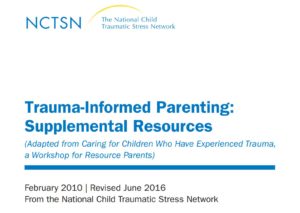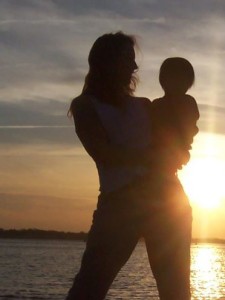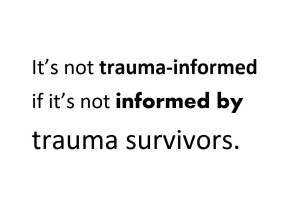Cross-posted at ACEsConnection Network where Gail Kennedy, Director of Programs, shared this fantastic resource with me last week.


It’s called: Trauma-Informed Parenting: Supplemental Resources and is available through the National Child Traumatic Stress Network (NCTSN) .
It was originally called Caring for Children Who Have Experienced Trauma and as part of a workshop for resource parents in the child welfare system. Resource parents, I believe, are are long-term and temporary foster parents as well as adoptive parents or those doing what’s been called therapeutic parenting.
Because it was such a great resource, facilitators and clinicians were distributing it more and more people – not only resource parents.
I’ve had a chance to read and review it for us at Parenting with ACEs. (If you want to join Parenting with ACEs, the group, you have to be part of the ACEsConnection Network. It’s free.
I know many of you are parents and some of you are advocates, activists and policy makers so you should know about it.
What’s Included
The sub-sections are in-depth but not too long. They are well-titled and self-explanatory. Here’s the list of the ones included and their length:
- The Essential Elements of Trauma-Informed Parenting
- 2 pages
- Child Traumatic Stress: A Primer for Parents
- 3 pages
- Understanding Brain Development in Young Children
- 7 pages
- This is comprehensive and has excellent references allowing people to dive deeper into research.
- The Invisible Suitcase: Meeting the Needs of Traumatized Children
- All sub-sections are good but this one is excellent, informative and sensitive.
- 3 pages
- Managing Emotional “Hot Spots”:Tips for Parents
- 3 pages
- Unfortunately, only the hot spots of the child/ren are discussed.
- 3 pages
- The Importance of Touch: Caring for Young Children Who Have Experienced Trauma
- 1 page
- Tuning Into Your Child’s Emotions: Tips for Parents
- 2 pages
- Developing Your Advocacy Skills
- 4 pages
- Helpful information but not geared towards all parents.
- Tips for Being Fabulous Trauma-Informed Parent
- 4 pages
- This section could be used as a stand-alone. It’s comprehensive, accessible and the easiest to read as it has lots of visuals as well as text. It’s my favorite and if you refer to nothing else, go to this.
- 4 pages
For parents without ACEs, it’s one of the best resources I have seen for describing traumatic stress. It explains adversity impacts children – except – it includes nothing about ACEs or parenting with ACEs.
What’s Missing
- Adverse Childhood Experiences (ACEs)
- There’s no mention of the ACE study at all or of the ACEs science.
- There is great information about brain development and the impact of trauma which includes neglect but not household dysfunction.
- There’s no mention of the ACE study at all or of the ACEs science.
- Trauma-informed Treatments Considered Effective
- Trauma-focused treatments with effectiveness established are referred to but not included, listed, explained or detailed. I’d love to know what they are as well and who and how they are deemed effective. What’s considered evidence-based isn’t always useful or appealing to people (child or adult) getting trauma treatment. I know MANY an adults who have sought (and are still seeking) treatments for trauma that are AT ALL. Traditional trauma treatments have had limited effectiveness for some and even been harmful to others. This topic deserves to be covered in detail.
- Integrating ACEs science more into the medical model when treating both physical and emotional health issues will likely improve outcomes. Also, when treatments said to be trauma informed are informed by the trauma survivors being treated, everyone will benefit. However, this is not yet done formally, routinely or at all outside of anecdotally (as in, “my patients say…” which is filtered and not unbiased or first-person data. If this is being done anywhere, please leave a comment, I’d love to learn more.
- Trauma-focused treatments with effectiveness established are referred to but not included, listed, explained or detailed. I’d love to know what they are as well and who and how they are deemed effective. What’s considered evidence-based isn’t always useful or appealing to people (child or adult) getting trauma treatment. I know MANY an adults who have sought (and are still seeking) treatments for trauma that are AT ALL. Traditional trauma treatments have had limited effectiveness for some and even been harmful to others. This topic deserves to be covered in detail.
- Language geared towards parents who are not foster parents.
- It is clear that it was once used for foster families as there are few stories or mentions of children with trauma and neglect outside of foster care. Given what we know about how common ACEs are this is a topic beneficial to all parents.
- Emphasis on Self-Care for Parents

- It is mentioned a few times and fabulous that this isn’t ignored. However, children and parents with ACEs need more self-care and will have a harder time prioritizing because of ACEs. This needs to be addressed directly and focused on in depth. How can people of all ages practice, manage and afford self-care? What’s self-care day to day, at home and on a budget? How can a kid or adult who doesn’t feel safe even consider self-care?
- Images and Space
- The document is long, single spaced and dense. I love words but I craved images so I know others will as well.
- Stories from Real-Life Families
- It’s accessible and informative research, which is WONDERFUL. It’s not all that warm and friendly though. It doesn’t include day to day life much or the voice of parents parenting. It can sound a little like a professional speaking down or at parent rather than relating with. It’s not overbearing to the point of being unable to read but it’s off-putting at times.
- Impact of Parenting with ACEs.

- There is nothing about parents who come to parenting with ACEs or trauma or traumatic stress. Since this is not a small number of people it’s too bad. The guide was written first for a targeted and specific group, resource parents, and maybe they already cover this topic elsewhere. However, it’s implied that this group doesn’t have a trauma history which is unlikely. (Disclosure: I’m a high ACE scoring adoptive parent who learned about healing and attachment while researching the impact of neglect and trauma on infants in orphanages). Remarkably, neglect wasn’t discussed in any of my own trauma treatment nor was attachment. For me, attachment parenting not only provided a parenting style and approach but a framework for my own healing. I know I’m not the only one. If non-resource parents and adults can learn a lot about healing from learning about child development and traumatic stress.
- The role of inter-generational trauma in families and the need and possibilities for multi-generational healing approaches isn’t addressed at all.

- The role of inter-generational trauma in families and the need and possibilities for multi-generational healing approaches isn’t addressed at all.
- There is nothing about parents who come to parenting with ACEs or trauma or traumatic stress. Since this is not a small number of people it’s too bad. The guide was written first for a targeted and specific group, resource parents, and maybe they already cover this topic elsewhere. However, it’s implied that this group doesn’t have a trauma history which is unlikely. (Disclosure: I’m a high ACE scoring adoptive parent who learned about healing and attachment while researching the impact of neglect and trauma on infants in orphanages). Remarkably, neglect wasn’t discussed in any of my own trauma treatment nor was attachment. For me, attachment parenting not only provided a parenting style and approach but a framework for my own healing. I know I’m not the only one. If non-resource parents and adults can learn a lot about healing from learning about child development and traumatic stress.
While there’s a lot to add and include and expand upon, this is a fantastic resource. I share all of this here with the hope it’s revised to be made even more accessible.
Still, as it is, it’s a document worth reading and sharing, personally and professionally.
This feedback is important for any organization or individual hoping to reach parents who are parenting kids with ACEs or parenting while managing past ACEs or both.
I recommend signing up at the National Child Traumatic Stress Network to access their extensive database. It’s for parents as well as professionals. They are fantastic!
Like the Network at ACEs, one must sign up to be part of the network, but it’s free and in addition to getting the above-mentioned guide (also free), there is a great Resource Parent Curriculum (RPC) Online section.
Here’s to all of the individuals and organizations who care about children and trauma survivors. Here’s to trauma-informed parents and trauma-informed parenting. Here’s to using ACEs science to educate and encourage self-healing in people and communities.
Let’s all stand and do an Amy Cuddy or Wonder Woman power pose!
You Matter Mantras
- Trauma sucks. You don't.
- Write to express not to impress.
- It's not trauma informed if it's not informed by trauma survivors.
- Breathing isn't optional.
You Are Invited Too & To:
- Heal Write Now on Facebook
- Parenting with ACEs at the ACEsConectionNetwork
- The #FacesOfPTSD campaign.
- When I'm not post-traumatically pissed or stressed I try to Twitter, Instagram & Pinterest.
Speak Your Mind